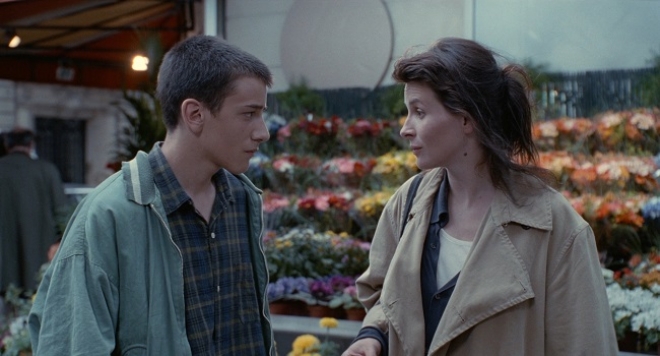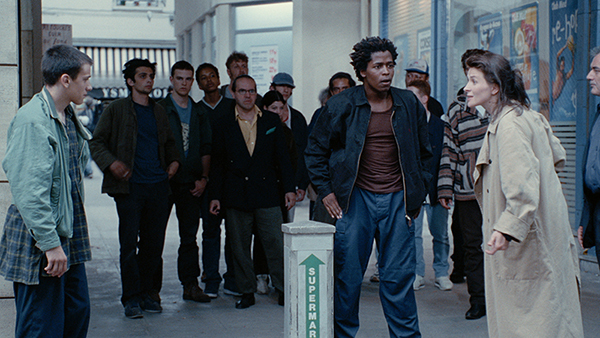Even before the recent events that occurred in Charlottesville, a certain scene from Michael Haneke’s 2000 film, Code Unknown (Code Inconnu), had been repeatedly playing on a loop in my mind’s eye. I quietly admitted to myself recently that the scene in question is without a doubt the most telling and poignant dramatic escalation I have seen in twenty-first-century cinema and it seems to show us as a viewer, even perhaps as a western nation, the dismantling of the mechanism that is used time and time again to increasingly expand injustice towards anyone who doesn’t fit into the stratagem of power. Haneke’s scene, and the film in general, however, is more specific but there are few filmmakers still working in the feature length narrative form that I feel have such an ability to diagnose our current political malady with such sharp precision.

Even before making the link between the potentially Adornian ideas of political sequencing and cutting, the images coming out of Charlottesville were already bringing thoughts of Haneke’s work to mind. When the images of Peter Cvjetanova began to circulate, raging proudly with tiki torch in hand, the protagonists from Funny Games (1997 & 2007) instantly came to mind. The likeness between this modern branch of fascism and the characters of Haneke’s American remake especially is startling. Even if the film did not work fully in its American guise, there is a clear and legitimate logic as to why that transfer of location for the narrative could have worked. More to the point, the comparison highlighted another main aspect to take away from these events; that, like the sadists in the film, these are explicitly middle-class mutations, educated in logic but devoid of empathy. In Haneke’s thesis, this is down to blind interaction with media which again is an unnerving parallel with our current reality. But it was in the aftermath of this event that the scene from Code Unknown began to replay once more.

The sequence in question is a single tracked shot lasting for over nine minutes. It follows the escalation of events stemming from the single action committed by the main character’s son. On walking down the street after finishing some food and bidding farewell to his mother (Juliette Binoche), Jean (Alexandre Hamidi) throws his rubbish heartlessly into the lap of a homeless woman, Maria (Luminita Gheorghiu). Witnessing this, Amadou (Ona Lu Yenke), the son of Malian immigrants, confronts Jean who is adamant on not apologising to Maria, herself an immigrant. The scene escalates as Jean intimates violence even though Amadou is clearly the stronger. They begin to scuffle until a crowd gathers, a shop keeper attempting to break up the fight until, eventually, Jean’s mother returns. The police then arrive, arresting Amadou who is later shown to be brutalised, and Maria who is later shown to be deported, the scene cutting as Amadou tries to stop the policemen from touching him while they arrest him; he has been the victim of the shopkeeper who has misinformed the police of what happened. The chain of events has that typical Haneke display of injustice, heightening further and further the stress caused by characters on screen being beyond reproach even when in the wrong.

The scene is very deliberate in its tracking and its lack of cutting. The vital nature of the scene is clear from seeing footage of a take going wrong in Michael H – Profession, Director (2013), where the actor playing the shopkeeper comes in too strong in his first attempt to break the fight up; he jumps the sequence’s heat too early. Haneke flies into a rage in this behind-the-scenes footage, the angriest footage that I have seen of the director. There is a reason for the take being perfected and in one shot in that, unlike the perspective of some of the characters including the mother, Haneke wants the viewer to see the full story, the full chain of the events so that the injustice is absolutely clear. If there was any attempt to edit, or to cut this sequence, there would be the potential to lose the strand of the implication, to perhaps even side against the wronged parties of Amadou and Maria. In order to see the scene from the mother’s perspective, simply cutting the first few minutes, coming straight into the tussle, shows the potential change in the effect. This is why it is positively Adornian in thinking. Rather like the recontextualising of full pieces of western art music into “hits” by radio and the technology of mass media, the act of such a recontextualisation is one of a power grab that benefits from economic and political stasis. The regressive listener is equally a regressive political entity, unable to consider basic moral problems and unaware of the deceptions that they are regularly fed.

The scene from Code Unknown plays to the opposite ideal, showing the full sequence of events so that the viewer is fully aware of what happened. Perhaps it is its particular interest in the racial injustices that made it stand out in my mind recently but then there’s no denying the depressing differences between its ideas and the commentary surrounding the fallout of Charlottesville. The current White House administration’s lack of full disavowal of extreme right groups was one thing, but the equating of genuine fascists with those who protested against them (in Donald Trump’s later outburst especially) was something different. He is cutting the narrative of the event to make it palatable to his dwindling and increasingly extreme base of supporters. He has effectively cut the scene and its overriding context away from the true cause of the violence and the horror of that event, very clearly because he knows that such people make up the very bottom of the barrel of his support to which is he currently and frantically scraping.

In an age of mass media, this has been an increasingly effective tool in the arsenal of those in power, seen in everything from Orgreave to Hillsborough,[1] but to make the cut so abrupt and so obvious for the public to see speaks of a frankly terrifying disregard for consequences or even care in maintaining the false narratives that they themselves created. Haneke’s film shows how the potential of such an unblinkered view of disturbing pathos allows the genuine wronged parties of an event to be perceived. It only, however, takes one too many “on many sides…” to finally rupture the genuine sequence of political reality, itself even more delicate than the reality of cinema. This is true most of all for those already in need of such narratives to bolster their evangelical ideology as they increasingly scramble to find what little vestige of morality they have left.

[1] The power of Jeremy Deller’s Battle Of Orgreave film comes from reinstating the “missing” segment of history which shows the true gensis of the violence being that of the authorities, famously edited on mainstream news to show the protestors and strikers charging first.

